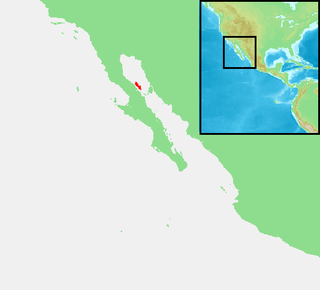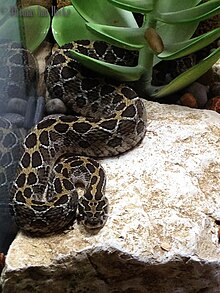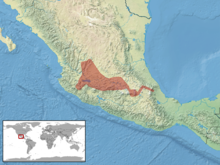
The black-tailed rattlesnake is a venomous pit viper species found in the southwestern United States and Mexico. Four subspecies are currently recognized, including the nominate subspecies described here.

Crotalus basiliscus, known as the Mexican west coast rattlesnake, Mexican green rattler, and also by other names, is a species of pit viper in the family Viperidae. The species is endemic to western Mexico. Like all other pit vipers, it is venomous. The specific name, basiliscus, is derived from the Greek word for king, βασιλισκος, and alludes to this snake's large size and potent venom. No subspecies are currently recognized.

Crotalus willardi is a venomous pit viper species found in the southwestern United States and Mexico. This snake is found mainly in the "sky island" region. The IUCN reports this snake's conservation status as being of Least Concern. It is the official state reptile of Arizona.

Crotalus ruber is a venomous pit viper species found in southwestern California in the United States and Baja California in Mexico. Three subspecies are currently recognized, including the nominate subspecies described here.

Crotalus mitchellii is a venomous pit viper species in the family Viperidae. The species is endemic to the Southwestern United States and adjacent northern Mexico. The species was named in honor of Silas Weir Mitchell (1829–1914), an American medical doctor who also studied rattlesnake venoms. Five subspecies are currently recognized, including the nominate subspecies described here.

Crotalus enyo, commonly known as the Baja California rattlesnake or Lower California rattlesnake, is a pit viper species native to the coast and islands of northwestern Mexico. Like all other pit vipers, it is venomous. Three subspecies are currently recognized, including the nominate subspecies described here.

Crotalus ravus, commonly known as the Mexican pigmy rattlesnake or Mexican pygmy rattlesnake, is a venomous pit viper species, found only in Mexico. Three subspecies are currently recognized.

Crotalus oreganus, commonly known as the (northern) Pacific rattlesnake, is a venomous pit viper species found in western North America from the Baja California Peninsula to the southern interior of British Columbia.

Crotalus atrox tortugensis is a venomous pit viper subspecies found only on Tortuga Island in the Gulf of California.

Crotalus pricei is a species of venomous snake, a pit viper in the family Viperidae. The species is endemic to the southwestern United States and northern Mexico. Two subspecies are recognized.

Crotalus lannomi, known commonly as the Autlán rattlesnake, is a species of venomous snake, a pit viper in the family Viperidae. The species is endemic to southwestern Mexico. There are no subspecies that are recognized as being valid.

Crotalus pusillus is a venomous pit viper species found in west-central Mexico. No subspecies are currently recognized.

Crotalus stejnegeri, commonly known as the Sinaloan long-tailed rattlesnake or just long-tailed rattlesnake, is a venomous pit viper species in the family Viperidae. The species is native to western Mexico. There are no recognized subspecies.

Crotalus transversus is a venomous pit viper species found in central Mexico, known from less than 20 specimens. No subspecies are currently recognized.

Crotalus triseriatus is a venomous pit viper species found in Mexico. Two subspecies are currently recognized, including the nominate subspecies described here.

Crotalus angelensis, or the Ángel de la Guarda Island speckled rattlesnake, is a pitviper species endemic to Isla Ángel de la Guarda in the Gulf of California, Mexico. Like all other pitvipers, it is venomous. It is sometimes treated as a subspecies of Crotalus mitchellii.

Crotalus oreganus caliginis is a venomous pit viper subspecies endemic to South Coronado Island, Mexico.

Crotalus estebanensis, commonly known as the San Esteban Island rattlesnake, is a pit viper species endemic to San Estéban Island, Mexico. Like all other pit vipers, it is venomous.
Crotalus lorenzoensis is a species of pitviper, a venomous snake in the subfamily Crotalinae of the family Viperidae. The species is endemic to San Lorenzo Sur Island, Mexico.
Crotalus mitchellii muertensis is a venomous pitviper subspecies endemic to El Muerto Island, Mexico. It is sometimes treated as a full species, Crotalus muertensis.




















